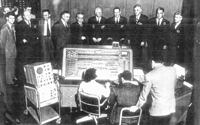Before the Department of Energy There Was . . . the Manhattan Project
May 9, 2001

Present at the dedication of the AEC Computing Facility at the Courant Institute in 1954 were (from left) Peter Lax; Sherman Lowell (behind Lax); General Whitney, Douglas MacArthur's aide de camp; James Stoker (behind Whitney); Eliezer Bromberg, director of the Computing Center; Gus Kinzel, vice president, Carbon and Carbide, and later chairman of the Advisory Council to the Courant Institute; Richard Courant; James Rand; Douglas MacArthur; Henry Heald, president of New York University; Lesley Groves; General Howley, commandant of the Berlin airlift in 1949, vice president of NYU.
In 1944, Lax said, von Neumann turned his attention to atomic bomb calculations, realizing that they couldn't be done analytically but had to be discretized and done numerically. "Being von Neumann," he realized that the computer was needed not only for the bomb but for other problems as well, not only for brute force calculations but also for providing insight. Von Neumann's early death (in 1957, at the age of 54) "deprived us of one of the most scintillating minds of our times," Lax said. During his last 10 years, von Neumann directed his attention to a wide range of problems---computational fluid dynamics, discretization and methods for solving the resulting linear equations, the effects of roundoff (with Herman Goldstine), the development of stability criteria for difference equations, and many others. Among the applications that attracted him was weather forecasting. (It's ironic, Lax pointed out, that although numerical calculations have been so successful in other areas, we still can't predict the weather.) It was also von Neumann who suggested that the computer be used for generating the pseudo-random numbers needed for Monte Carlo calculations (with truly random numbers, generated by an analog process, the calculations could not be repeated, which would make it hard to debug a program).
A hands-on person, von Neumann liked to write code. He was also very interested in computer architecture and hardware. He didn't live to see transistors, Lax said; "he would have been thrilled."
"To the disgust of the mathematics department at the Institute for Advanced Study," Lax said, von Neumann wanted to build a computer at the Institute. (In 1987, the Association for Computing Machinery held a meeting on the history of computing at IAS, which was considered an especially appropriate site. Actually, Lax pointed out, it was anything but: The prevailing view at IAS was that von Neumann "had saddled them with the computer," and the project was terminated the day after his death.)
One of five commissioners of the AEC, Von Neumann was, "because of his ability to analyze things," the most influential. One of his priorities was to ensure that university scientists had access to computing facilities, and to that end the AEC asked the Courant Institute to administer one of its computers. The dedication of the AEC Computing Facility at Courant was a big occasion, Lax said, illustrating with the 1954 photograph shown above: James Rand, chairman of the Remington Rand Corporation, was present for the occasion (fifth from right); after much deliberation, someone in the audience identified the person to the right of Rand in the photo: General Douglas MacArthur, chairman of the Remington Rand board. Other prominent generals appear in the photograph, Lax said, including Lesley Groves, head of the Manhattan Project and a member of the Remington Rand board (second from right), along with Richard Courant (to Rand's left in the photo) and a young Peter Lax (far left).

